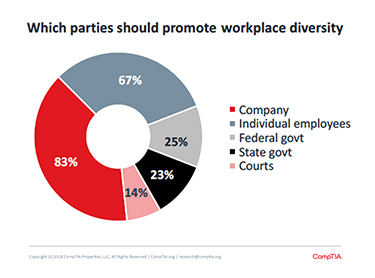 Small businesses can benefit from examining their own diversity data, even if there are only 20 people in the office.
Small businesses can benefit from examining their own diversity data, even if there are only 20 people in the office.
“Releasing diversity reports publicly has been a bit of a trend in tech since Google did it a few years ago, but other industries and organizations who are federal contractors have been conducting these public exercises for years,” said Ulysses Smith, an inclusion and diversity strategist and founder of Archetype D&I Consulting.
The results of a D&I report are meant to help you understand your company’s blind spots and find different lenses to view diversity: race, gender, class and identity.
“We need to stop thinking about it as a numbers game,” said Carolyn April, senior director of industry analysis for CompTIA. Candidates from different backgrounds will bring you a diversity in terms of innovation and skills and from a business success standpoint, that’s worth investing in. “Having diversity in backgrounds and skill-sets sparks innovation and new ideas within a company.”
Referencing CompTIA’s research report, Diversity in the High Tech Industry, April said for a successful diversity and inclusion movement to happen the directive must come from the top. In the report, 70 percent of both high-tech and general business respondents said they believe the responsibility of setting the tone and agenda that encourages and supports workplace diversity lies with company leaders.
“There has to be buy-in from the employees, too,” she said.
Who and What to Count
Look at your workforce by race and gender and examine these demographics by job group, how much they’re compensated and the track to promotion or termination, Smith recommended. Then expand into gender identity, sexual orientation, ability, veteran and family status as well as educational attainment.
“Use voluntary self-identification information to capture the baseline demographics,” Smith said. “This information can be collected using a survey tool, most often as part of a regular employee engagement survey.”
It’s important the data expand beyond race and gender and to note diversity in managerial roles versus hourly workers as well.
“In CompTIA’s diversity study, we found blacks and Latinos are often underrepresented in high tech while the Asian population in high tech is highly represented, even over-represented based on population, but not busting through middle management for the most part,” April said.
She used the hospitality industry to illustrate her point: It’s a highly diverse industry overall, but not at the CEO, C-suite or even director levels.
“They can do a diversity report to start counting numbers and they look great on paper, but you have to look at the management level you have to see diversity there, otherwise you’re not actually a company that’s doing well in diversity,” April said.
Break Down the Data
Analyze your workforce data by division, team and job category. Smith said this type of analysis will help you identify strategies to balance teams and identify inequities between groups.
An organization may say women make up 40 percent of its workforce, Smith said, but a team breakdown might show that 80 percent of those women are concentrated in HR, 15 percent are in marketing and just 5 percent work in engineering. “The disparity might be worse when you examine it by organizational level,” Smith said.
Compare Data with Demographics
When you’re analyzing the data, understand the demographics of your recruiting area. Look at the open source data from the Equal Employment Opportunity Commission (EEOC) to track applicant demographics and compare it with both applicant and workforce data.
“This information is incredibly valuable if you are trying to assess the success of recruiting efforts and to determine areas of opportunity,” Smith said. “If applicant data is far disconnected from availability data, then recruitment efforts are likely misplaced.”
For geographies where the applicant pool is very white, companies need to expand the idea of diversity beyond race and focus on people from different genders, classes and identities.
“It’s hard to be critical of companies who face that situation,” April said, “but there are ways to get creative, like hiring out of state applicants who can work remotely.”
Consider People You Passed Up
Tracking applicant pass-through rates by demographic can help you, Smith said.
“For example, you may have a high number of black applicants for a role, yet none or very few seem to make it beyond the phone interview,” Smith said. “What is happening at the recruiter screen phase that is causing the drop?”
If you’ve collected demographic data during the application stage, you should be able to assess where groups are falling out of the process and if there are any troubling trends, he said.
Ask People About Their Experiences
When you collect your data, add questions in the engagement survey about inclusion and belonging and break down responses by demographics to see if there are any major themes or disparities.
“Understanding the lived experience of different employee groups may shed some insight into why many of your recruitment efforts have failed,” Smith said. “There may be perceptions of pay inequity, unfair policy application, management dynamics, lack of support and development, or other things that impact these results.”
Once you’ve collected and analyzed your data, you can develop a comprehensive report and use the information to develop a long-term strategy for diversity and inclusion. For more tips and seminars related to diversity and inclusion, connect with members of CompTIA’s Advancing Diversity in Technology Community.
CompTIA’s ADIT Community is dedicated to supporting and promoting workforce diversity, helping companies create work environments inclusive of all people. To connect with members today, join the ADIT discussion group.
Michelle Lange is a writer and designer living in Chicago.
 Add CompTIA to your favorite RSS reader
Add CompTIA to your favorite RSS reader

